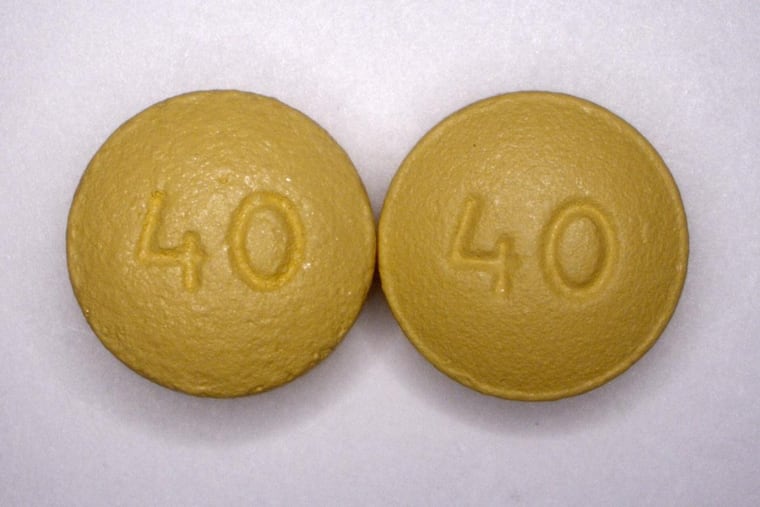Opioid prescriptions are dropping — from sky high to just high
The number of painkiller doses per capita was down or stable in all Philadelphia-area counties over five years.

The number of painkiller prescriptions in the United States has been declining for several years, but doctors in 2015 still prescribed enough opioids to medicate every American around the clock for three weeks straight, federal health officials reported Thursday. That's quadruple the prescribing rate in Europe.
While announcing a rare bit of good news regarding a prescription drug epidemic that has killed nearly 180,000 Americans in 15 years, officials sounded less than upbeat in a teleconference with reporters Thursday.
"The amount of opioids prescribed in the U.S. is still too high, with too many opioid prescriptions for too many days at too high a dosage," said Anne Schuchat, acting director of the Centers for Disease Control and Prevention.
Prescriptions per capita, measured in morphine equivalents to account for various strengths and drug types, have declined steadily since their 2010 peak, she said, but still are triple what they were in 1999.
Half the nation's counties saw a decline (a quarter were stable) from 2010 to 2015. But there was wide variation, with providers in the highest-prescribing counties writing scripts for six times more opioids per resident than those in the lowest-prescribing counties.
Nationally, the epidemic has been driven by high rates of addiction in more rural and white areas. But most counties in the densely populated Philadelphia region had above-average prescribing rates, with South Jersey even higher than its Pennsylvania neighbors. The number of prescriptions per capita was down or slightly up in all eight counties.
The national data illustrate some of the challenges doctors and policymakers continue to face. While prescriptions per capita, as well as the rate of new prescriptions, have declined, the average duration of each script increased by a third, from 13.3 days to 17.7. Using opioids for longer stretches, even at low doses, dramatically raises the risk of overdose and death.
And although dosages have dropped — the average daily morphine equivalent per prescription decreased from 59.7 mg in 2006 to 48.1 mg in 2016 — they are still troubling, officials said. A morphine equivalent of 50 mg a day (33 mg of oxycodone or 12.5 mg of hydromorphone) carries double the risk of fatal overdose compared with 20 mg; a 90 mg dose increases the risk 10 times.
Addiction to prescription opioids sometimes leads patients to buy pills or much cheaper heroin on the street. Heroin is increasingly mixed with dangerous illicit versions of fentanyl in unpredictable amounts.
However, a JAMA viewpoint article that accompanied Thursday's CDC report noted, citing other research, that there is no evidence to support the belief that efforts to reduce inappropriate opioid prescribing have driven more people to heroin.
Looking at county-level prescribing data helped CDC researchers to shed more light on some patterns of the painkiller epidemic. Counties with high rates tended to:
Contain small cities or large towns (perhaps with pharmacies that drew residents from rural areas)
Have higher percentages of white residents
Have more dentists and primary-care physicians per capita
Have more residents who were uninsured or unemployed
Have more people with diabetes, arthritis, or a disability
But county-by-county analyses also illustrated how much is unknown about where and why opioids are given. In the Philadelphia region, for example, every county but Chester exceeded the national average prescriptions per capita. And Philadelphia, which has the highest drug death rate in the state, was only a few notches above the Pennsylvania average, and lower than most surrounding suburbs, for opioid prescriptions per capita.
Overall, New Jersey's death toll is considerably less than Pennsylvania's. But South Jersey's death rate has been higher than the rest of the state's, and the new data may offer a clue. Opioid prescriptions per capita were higher in every South Jersey county compared with the state's central and northern regions, with Camden, Cape May, Gloucester, and Burlington making up the top four in 2015.
Addiction experts in New Jersey say that the lack of treatment facilities in the southern counties is a major impediment. Funding for treatment has become a hot-button national issue as Republicans in Congress try to repeal and replace the Affordable Care Act.
The ACA's Medicaid expansion is credited with making treatment more widely available, and among the "essential benefits" that the law requires private insurance plans to cover are mental health and substance abuse treatment. The Wolf administration, which strongly supports the law, says that more than 170,000 Pennsylvania residents have received addiction treatment through either the Medicaid expansion or private insurance sold on the ACA exchanges.
The Republican plans would roll back Medicaid expansion and further reduce previously existing Medicaid programs, which together fund many people in treatment. The latest GOP proposal in the Senate would allow states to seek waivers to the essential benefits requirements for private plans.
Before leaving on a 10-day break, the Senate leadership reportedly had agreed to a demand by Republican moderates from states hard-hit by addiction to include $48 million over 10 years to deal with opioids. But critics say treatment costs could add up to several times that amount.